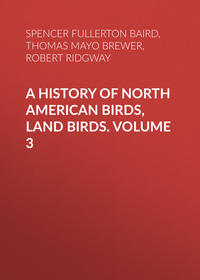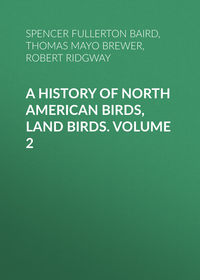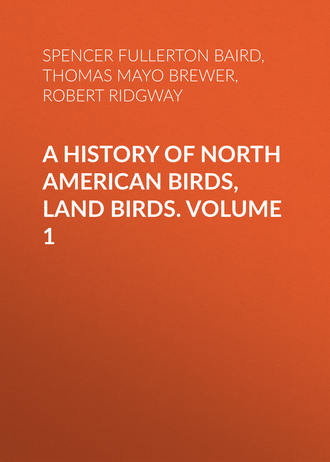 полная версия
полная версияA History of North American Birds, Land Birds. Volume 1
The general habits of these birds correspond closely with those of the large family to which they belong. They move usually in small flocks of from five to ten through the branches of trees and bushes in quest of insects, examine the cracks and crevices of the bark, hang on the under side of small branches, move sideways around the trunks of trees, probe the openings in acorns, pine-cones, nuts, etc., for its food, and retain apparently the family group until the spring, when they separate into pairs.
One of these birds kept in confinement by Dr. Bachman of Charleston was in the habit of hiding its food in the corner of its cage, in a small crevice, and of creeping at night into a small box, where it lay doubled up like a ball till the first light of the morning, when it resumed its restless habits.
The Tufted Titmouse passes its nights and days, when the weather is inclement, in the hollows of decayed trees or the deserted holes of the woodpeckers. In such places it also builds its nests. It has been known to excavate a hole for itself even in hard sound wood. Its nest is simply a rude lining of the selected cavity, composed of various soft and warm materials. In this are deposited from six to eight eggs. But a single brood is raised in a season. The young birds, as soon as they are fledged, hunt in company with their parents, and remain associated with them until the following spring. The eggs of this bird have a length of .75 of an inch and a breadth of .56. They are of a rounded oval in shape, and are thickly sprinkled with fine rust-colored dots, intermingled with a few larger markings of lilac, on a white ground.
Lophophanes atricristatus, CassinBLACK-TUFTED TITMOUSE; TEXAS TITMOUSEParus atricristatus, Cassin, Pr. A. N. Sc. Phil. V, 1850, 103, pl. ii (Texas). Lophophanes atricristatus, Cassin, Ill. Birds Texas, etc. I, 1853, 13, pl. iii.—Baird, Birds N. Am. 1858, 385; Review, 78.—Cooper, Birds Cal. 1, 43.
Sp. Char. Crest very long and pointed (1.25 inches). Above ash-colored. A broad band on the forehead dirty white, rest of head above, with crest, black, tinged with ash on the sides. Color of the back shading insensibly into the dull ashy-white of the under parts. Sides of body pale brownish-chestnut. Female with the crest duller black. Iris dark brown. Length, about 5.25 inches; wing, 3.00.
Hab. Valley of Rio Grande, south, into Mexico. San Antonio. Texas. Vera Cruz, Sclater.
This species is not rare in Texas, where it has been noticed as far east as San Antonio.
Habits. So far as known, the Black-crested Titmouse is restricted in its distribution to the valley of the Rio Grande, including portions of Mexico and Western Texas. It was first met with in the latter State by John W. Audubon, and described by Mr. Cassin in the Proceedings of the Philadelphia Academy.
In its general appearance and in all its habits it is mentioned as having so close a resemblance to the common Tufted Titmouse as to be hardly distinguishable from that bird. Dr. Woodhouse met with this species near San Antonio, Texas, in March, 1851. While his party was encamped on the Rio Salado he observed these birds busily engaged in capturing insects among the trees on the banks of the stream. Like all the members of this family, it was incessantly in motion and very noisy. Later in the season, on the 8th of May, the same party, when encamped on the Quihi, again found this species very abundant among the oaks. The young males, then fully grown, closely resembled the adult females, both wanting the black crest that distinguishes the mature male. He afterward noticed this species occurring at intervals along his route as far as the head waters of the Rio San Francisco in New Mexico. He observed it almost exclusively among the trees that bordered streams of water. The females and the young males invariably had crests of the same cinereous color as their general plumage, but in the latter slightly tinged with brown. They occurred in small parties, were very lively and sociable in their habits, and in their general appearance and even in their notes so very closely resembled the Eastern species as, at a short distance, to be hardly distinguishable from it.
Dr. Heermann, in his report on the birds of Lieutenant Parke’s survey, mentions having first observed this species near Fort Clarke, in Texas, where it was very abundant. He describes it as sprightly and active in its movements, searching with great assiduity for insects in the crevices of the bark and among the branches of trees. While thus engaged it keeps up a chattering note, varied with an occasional low and plaintive whistle. Its habits appeared to him to resemble most those of the common Parus atricapillus. Dr. Heermann states that it builds its nest in the hollow of trees, and that it lays from twelve to sixteen eggs. He does not, however, say that he ever met with its eggs, nor does he give any description of them. The nest, he states, is composed of fine dry grasses, feathers, wool, mosses, etc.
General Couch’s description of this species and its habits is very similar. He observed it in the province of New Leon, in Mexico, where he found it very abundant along the San Juan into the Sierra Madre. He describes it as a very lively bird, with a very perfect whistle of a single note.
Mr. Henry A. Dresser sought very diligently for its nest and eggs near San Antonio and Houston, in Texas, where he found the bird very common, and where he was sure many pairs remained to breed, but its nest was very hard to find, and the birds very wary. He succeeded in finding one nest, in a hollow tree, near the head springs of the San Antonio River, but it contained young. The nest he does not describe, nor does he mention the number of young it contained.
Lophophanes inornatus, CassinGRAY-TUFTED TITMOUSE; CALIFORNIA TITMOUSEParus inornatus, Gambel, Pr. A. N. Sc. Phil. Aug. 1845, 265 (Upper California).—Ib. J. A. N. Sc. new ser. I, 1847, 35, pl. vii. Lophophanes inornatus, Cassin, Ill. 1853, 19.—Baird, Birds N. Am. 1858, 386; Review, 78.—Sclater, Catal. 1861, 14, no. 88.—Elliot, Illust. I, pl. iii.—Cooper, Birds Cal. 1, 42.
Sp. Char. Crest elongated. Color above olivaceous-ashy, beneath whitish. Sides of body and under tail-coverts very faintly tinged with brownish, scarcely appreciable. Sides of head scarcely different from the crown. Forehead obscurely whitish. Length, 5 inches; wing, 2.55.
Hab. Southern United States, from Rocky Mountains to Pacific; Western Nevada (Ridgway). W. Arizona (Coues).
The bill and feet of this species are lead-color. The third, fourth, and fifth quills are longest; the third and eighth about equal; the second is shorter than the shortest primaries. The lateral tail-feathers are a little shorter than the others.
A specimen from Fort Thorn has the crest longer than in other specimens before me, measuring 1.35 inches from base of bill to its tip. This may be a characteristic of the male, the sexes being otherwise alike.
Habits. The Gray Titmouse belongs essentially to the Pacific coast, coming eastward only as far as the banks of the Rio Grande in Texas. It was first discovered and described by Dr. Gambel, in his Birds of California. It has since been met with not only throughout California, but also in all the southern portions of the Rocky Mountains, in New Mexico, and from Mimbres to the Rio Grande.
Dr. Woodhouse met with this species in the San Francisco Mountains, near the Little Colorado River, New Mexico. He found it very abundant, feeding among the tall pines in company with the Sitta pygmæa, S. aculeata, and Parus montanus.
Dr. Gambel first noticed this species near Monterey on the 20th of November. It was flitting actively about among the evergreen oaks of that vicinity in company with large flocks of several kindred species. They were all in restless activity, searching every branch for insects. As well as he could distinguish its notes among those of the busy throng in the midst of which he observed it, they appeared to resemble very closely those of the common P. atricapillus. Upon his following it up, it would utter a loud scolding outcry, erect its high and pointed crest, and appear as angry as possible at the intrusion. He found it very common, frequenting tall bushes in small flocks, searching branches of low trees, uttering weak and slender cries, resembling the syllables tsēē dāy-dāy.
Dr. Heermann found it one of the most common of the birds of California, where it is resident throughout the year. He describes their notes as possessing an almost endless variety, so much so that he was repeatedly prompted to follow it as a new species. He met with a nest of this bird in a deserted woodpecker’s hole, which contained young.
Dr. Cooper has met with this species in February near San Diego, but not on the Colorado. They seem to prefer the evergreen-oak groves toward the middle of the State, but are not found in the higher Sierra Nevada. They are residents throughout the year in the evergreen oaks near San Francisco. He adds that they are seen in small parties, scattered about the trees, and calling to each other with a variety of sweet and loud notes, some of which are said to equal those of our best singers. It also has certain powers of imitation like the Eastern crested species and the same cry of pēto-pēto.
It feeds on acorns as well as insects, and often goes to the ground in search of them. It cracks the acorns with its bill, and hammers at bark and decayed wood with the industry of a woodpecker.
Mr. Ridgway met with this species among the pines of the eastern slope of the Sierra Nevada, but nowhere in abundance. Among the cedars it was almost the only bird seen. He describes its manners as greatly resembling those of the other species. Its notes, though differing from those of the Eastern L. bicolor, being weaker and less distinct, retain its vehement and characteristic manner of utterance.
Lophophanes wollweberi, BonapWOLLWEBER’S TITMOUSE; STRIPED-HEADED TITMOUSELophophanes wollweberi, Bon. C. R. XXXI, Sept. 1850, 478.—Westermann, Bijdr. Dierkunde, III, 1851, 15, plate.—Baird, Birds N. Am. 1858, 386, pl. liii, fig. 1; Review, 79.—Sclater, P. Z. S. 1858, 299 (Oaxaca, high lands).—Ib. Catal. 1861, 14, No. 89.—Cooper, Birds Cal. 1, 43. Parus annexus, Cassin, Pr. A. N. Sc. V, Oct. 1850, 103, pl. i. Lophophanes galeatus, Cabanis, Mus. Hein. 1850, 1851, 90.
Sp. Char. Central portion of crest ash, encircled by black, commencing as a frontal band, and passing over the eye. Chin, throat, and a line from behind the eye and curving round the auriculars to the throat (bordered behind by white), as also some occipital feathers, black. A white line from above the eye margining the crest, with the cheeks below the eye and under parts generally white. A black half-collar on the nape. Upper parts of body ashy. Length, about 4.50; wing, 2.50.
Hab. Southern Rocky Mountains of United States, and along table-lands through Mexico, to Oaxaca (high regions, Sclater). Orizaba (Alpine regions, Sum.).
Habits. Wollweber’s Titmouse, so far as its distribution is known, is a bird of Western Texas, the high table-lands of Mexico, and of the whole of New Mexico. It was described by Bonaparte and by Cassin nearly simultaneously, in 1850. It bears a very close resemblance to the Lophophanes cristatus of Europe.
Although comparatively nothing is known in reference to the specific habits of this species, they may be very readily inferred from those of the other members of this genus, whose characteristics are all so well marked and so uniform. Dr. Kennerly is the only one of our naturalists who has mentioned meeting the species in its living form. In his Report upon the Birds of Lieutenant Whipple’s Survey he states that he found it in the thick bushes along the Pueblo Creek. Wherever noticed it was constantly in motion, hopping from twig to twig in search of its food. He also found it among the pines of the Aztec Mountains. No mention is made of its nest or eggs, and its nidification remains to be ascertained.
Genus PARUS, LinnæusParus, Linnæus, Syst. Nat. 1735. (Type, P. major.)
Gen. Char. Head not crested. Body and head full. Tail moderately long, and slightly rounded. Bill conical, not very stout; the upper and under outlines very gently and slightly convex. Tarsus but little longer than middle toe. Head and neck generally black or brown, with sides white. Nest in holes. Eggs white, sprinkled with red.
In the group, as defined above, are embraced several genera of modern systematists. The true black-capped American Titmice belong to the section Pœcile of Kaup, and exhibit but three well-marked forms; one, P. montanus, with a white stripe over the eye; one, atricapillus, without it, with black head; and one, hudsonicus, also without it, and with brown head. The species may be arranged as follows:—
1. Head and neck, above and beneath, black; their sides whiteA. A broad white stripe above the eye, meeting across forehead.
1. P. montanus. Edges of wing-coverts, secondaries, and tail scarcely paler than general tint above. Beneath ashy-whitish, medially. Wing, 2.85; tail, 2.50; bill (along culmen), .50; tarsus, .69; middle toe, .43; wing-formula, 4 = 5, 3 = 6, 7, 2; graduation of tail, .18. Hab. Mountain regions of Middle and Western United States.
B. No white stripe above the eye.
a. Tail as long as, or longer than, wing. conspicuous white edgings to wing-coverts, secondaries, and tail-feathers.
2. P. atricapillus.
Dorsal region yellowish-cinereous, wings and tail purer ash; sides light ochraceous. White edgings of tail-feathers not margining their ends. Wing, 2.60; tail, 2.60; bill, .40; tarsus, .62; middle toe, .36; wing-formula, 4, 5, 6, 3, 7, 8, 2 = 9; graduation of tail, .30. (12,851 ♂: Brooklyn, N. Y.) Hab. Eastern Province of North America, north of about 39° … var. atricapillus.
Dorsal region and sides with scarcely a perceptible yellowish tinge; white edgings of tail-feathers passing around their ends. Beneath whitish. Wing, 2.75; tail, 2.80; culmen, .35; tarsus, .65; middle toe, .40; wing-formula, 5, 4 = 6, 3 = 7, 8, 2 = 9; graduation of tail, .50. (3704 ♂? Salt Lake City, Utah.) Hab. Region of Missouri River and Rocky Mountains … var. septentrionalis.
Colors as in atricapillus, but much darker. Beneath more ochraceous. Wing, 2.40; tail, 2.50; culmen, .40; tarsus, .60; middle toe, .40; wing-formula, 4th, 5th, and 6th equal, 3 = 7, 2 = 10; graduation of tail, .25. (6762 ♂? Fort Vancouver, Washington Territory.) Hab. Pacific Province of North America … var. occidentalis.
b. Tail shorter than wing; no conspicuous white edgings to wings and tail.
3. P. meridionalis.27 Beneath ashy (nearly dark as upper surface), whitish medially. Wing, 2.60; tail, 2.20; culmen, .40; tarsus, .63; middle toe, .40; wing-formula, 4, 5, 6, 3 = 7, 2 = 10; graduation of tail, .10. (10,203, Mexico.) Hab. Eastern Mexico.
4. P. carolinensis. Beneath pale soiled ochraceous-whitish, scarcely lighter medially. Wing, 2.55; tail, 2.30; culmen, .35; tarsus, .53; middle toe, .38; wing-formula, 5, 4, 6, 7, 3, 8, 2 = 9; graduation of tail, .10. (706 ♂, Washington, D. C.) Hab. Eastern Province of United States, south of about 40°.
2. Head and neck, above and beneath, brown, the throat darkest; their sides whiteC. Back, scapulars, rump, and sides rusty-chestnut.
5. P. rufescens. Side of neck pure white. Wing, 2.35; tail, 2.00; tarsus, .61; middle toe, .40. Tail scarcely graduated. Hab. Pacific coast of North America.
D. Back, etc., grayish or ochraceous brown.
6. P. hudsonicus. Side of neck grayish. Back, etc., smoky-gray. Sides dark rusty-brown. Wing, 2.45; tail, 2.45; tarsus, .62; middle toe, .35; graduation of tail, .30. (17,101, Halifax, N. S.) Hab. Arctic America; south to northern boundary of the United States (except to westward).
7. P. sibiricus.28 Side of neck white. Back, etc., rusty ochraceous-gray. Sides rusty ochraceous. Wing, 2.70; tail, 2.80; tarsus, .66; middle toe, .36; graduation of tail, .30. Hab. Europe.
Parus montanus, GambelMOUNTAIN CHICKADEE: WHITE-BROWED CHICKADEEParus montanus, Gambel, Pr. A. N. S. Phila. April, 1843, 259; Journ. A. N. Sc. 2d Series, I, 1847, 35, pl. viii, f. 1.—Baird, B. N. A. 1858, 394; Review Am. B. I, 1864, 82.—Elliot, Illust.—Cooper, Birds Cal. 1, 46.
Sp. Char. Head and neck above, with under part of head and throat, glossy black; forehead, stripe above the eye and band below it, involving the auriculars, white. These stripes embracing between them a black band through the eye and confluent with the black of the head. Above ashy; beneath similar, but paler; the upper part of breast and middle line of belly white. Length about 5 inches; wing, 2.60; tail, 2.40.
Hab. Mountain region of Middle and Western United States.
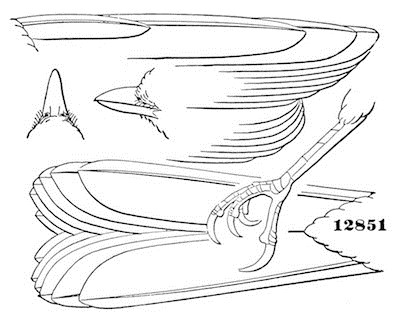
Parus atricapillus.
12851
Habits. The Mountain Chickadee was first met with by Dr. Gambel in journeying westward from Santa Fé, in New Mexico, and from thence was found in all the ranges of the Rocky Mountains nearly to California. Its notes and habits are said to closely resemble those of the common Chickadee, but weaker and more varied. It keeps more in low bushes, where it moves from branch to branch with untiring activity, searching each minutely for small insects. It also frequently descends to the ground to pick up small seeds. While thus occupied it will occasionally stop, look round, and, uttering a slender te-de-de, and then its usual note, to-de-de-dait, will fly to another bush.
On the Rio Colorado they kept chiefly among the cotton-wood trees that grew along its banks, and its familiar notes were almost the only sounds heard. They were observed in large and busy flocks along the smaller streams in company with the Least Tit and the Reguli. Dr. Gambel did not find them, however, so abundant on the California sides of the ridge, where other species took their place.
Dr. Heermann found this Titmouse abundant among the mountains surrounding the Volcano in the southern mines, and subsequently met with them on the summit of the Tejon Pass. He thinks their notes and habits very similar to those of the atricapillus. Dr. Suckley obtained a single specimen at Fort Dalles, but regarded it as extremely rare in that locality. Dr. Woodhouse found it quite abundant in the San Francisco Mountains of New Mexico, where it was feeding among the tall pines in company with kindred species.
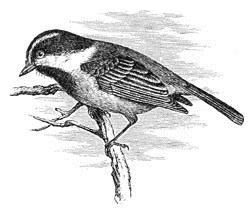
Parus montanus.
Mr. Ridgway found this species in great abundance among the pines on the eastern slope of the Sierra Nevada Mountains, as well as in all the extensive cedar-groves on the mountains to the eastward. Around Carson City this species was found throughout the winter. In its manners and notes, particularly the latter, it was hardly distinguishable from P. carolinensis. The notes are described as louder and more distinct, though their calls in spring are rather less clearly articulated.
Parus atricapillus, LinnEASTERN CHICKADEE; BLACK-CAPPED TITMOUSEParus atricapillus, Linn. Syst. Nat. I, 1766, 341 (based on Parus atricapillus canadensis, Brisson, III, 553, tab. xxix, fig. 1).—Baird, Birds N. Am. 1858, 390; Review, 80.—Sclater, Catal. 1861, 13, No. 80.—Dall & Bannister (Alaska).—Samuels, 182. Pœcile atricapilla, Bon. Consp. 1850, 230. Parus palustris, Nutt. Man. I, 1832, 79.
Figured by Audubon, Wilson, etc.
Sp. Char. Second quill as long as the secondaries. Tail very slightly rounded; lateral feathers about .10 shorter than middle. Back brownish-ashy. Top of head and throat black, sides of head between them white. Beneath whitish; brownish-white on the sides. Sides of outer tail-feathers, some of primaries, and secondaries conspicuously margined with white. Length, 5.00; wing, 2.50; tail, 2.50.
Hab. Eastern North America, north of 39th parallel.
In this species the first quill is spurious; the fourth quill is longest; the fifth and sixth successively a little shorter; the third is about equal to, or a little shorter than, the eighth; the second is a very little longer than the secondaries. The tail is a little rounded, the innermost feather longest, the rest successively a little shorter. The greatest difference in length of tail-feathers amounts to .30 of an inch.
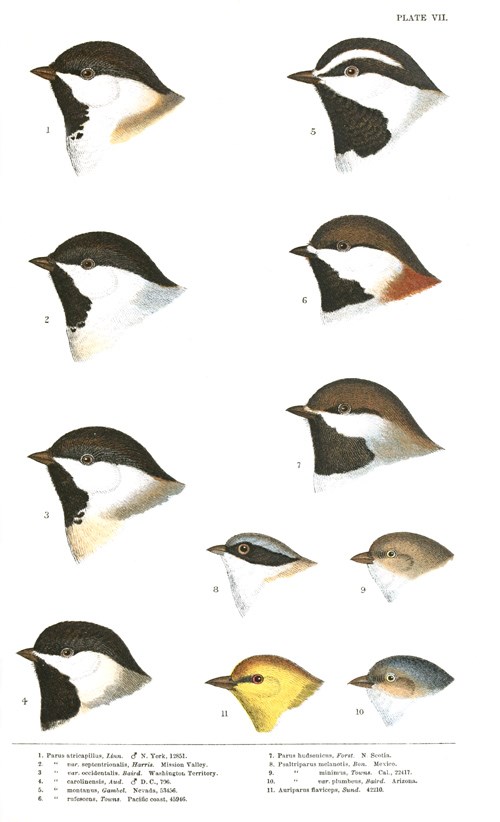
PLATE VII.
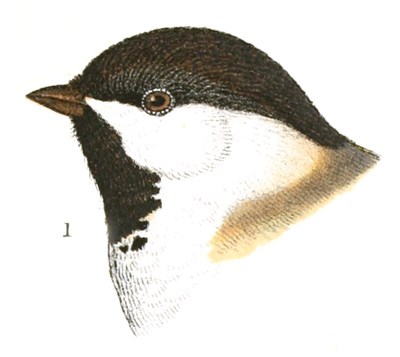
1. Parus atricapillus, Linn. ♂ N. York, 12851.
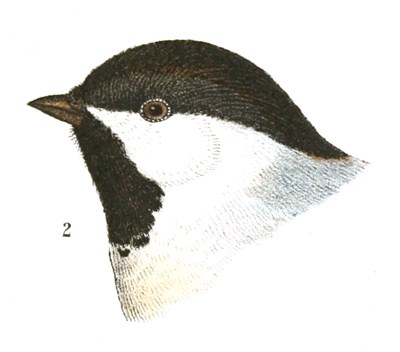
2. Parus var. septentrionalis, Harris. Mission Valley.
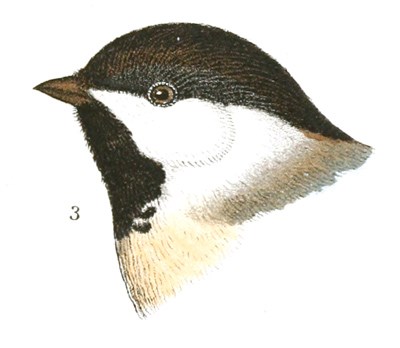
3. Parus var. occidentalis, Baird. Washington Territory.
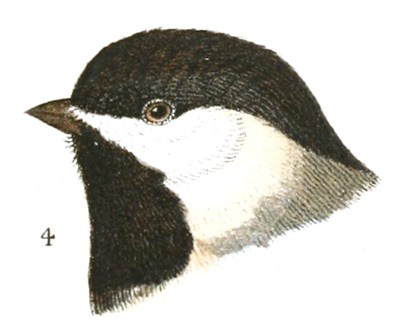
4. Parus carolinensis, Aud. ♂ D. C., 706.
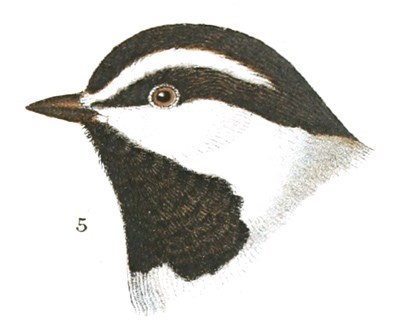
5. Parus montanus, Gambel. Nevada, 53456.
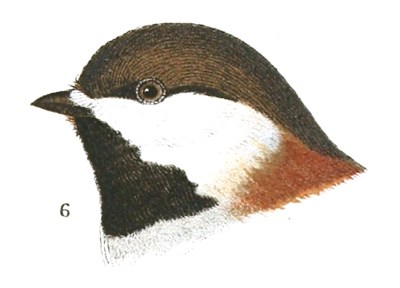
6. Parus rufescens, Towns. Pacific coast, 45946.
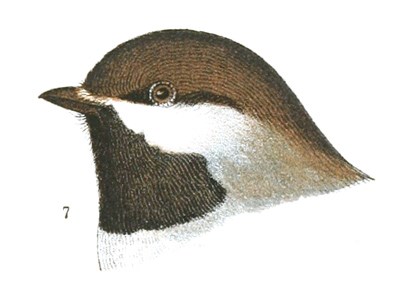
7. Parus hudsonicus, Forst. N. Scotia.
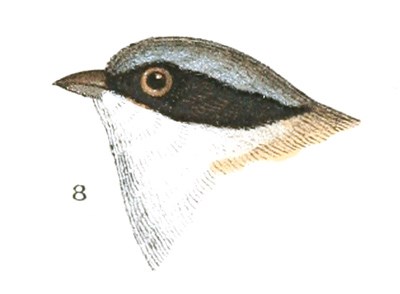
8. Psaltriparus melanotis, Bon. Mexico.
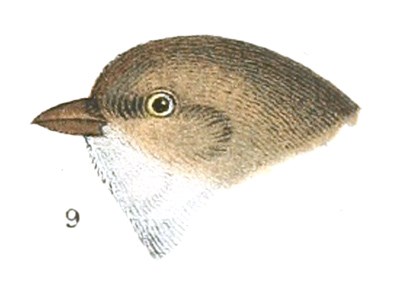
9. Psaltriparus minimus, Towns. Cal. 22417.

10. Psaltriparus var. plumbeus, Baird. Arizona.
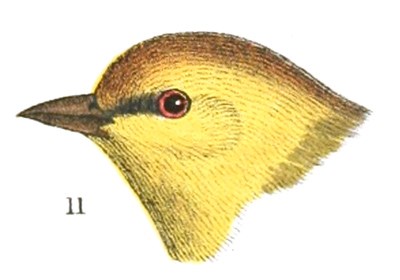
11. Auriparus flaviceps, Sund. 42210.
The entire crown, from the bill to the upper part of the back, coming down on the sides to the lower level of the eye, is pure black, although the edge alone of the lower eyelid is of this color. A second black patch begins at the lower mandible and occupies the entire under surface of the head and throat, but not extending as far back within a quarter of an inch as that on the upper part of the neck. The space between these two patches, on the sides of the head and neck, is white, this color extending along the black of the back of the neck as far as its truncated extremity, but not bordering it behind. The middle of the breast and belly, as far as the vent, is dull white, that immediately behind the black of the throat a little clearer. The sides of the breast and body under the wings, with the under tail-coverts, are pale, dull brownish-white. The back, rump, and upper tail-coverts are of a dirty bluish-ash, washed with yellowish-brown, especially on the rump. The wings are brown; the outer edges of the third to the seventh primaries narrowly edged with whitish; the innermost secondaries more broadly and conspicuously edged with the same; larger coverts edged with dirty whitish. Outer webs of tail-feathers edged with white, purest and occupying half the web in the external one, narrowing and less clear to the central feathers, the basal portions, especially, assuming more the color of the back.




